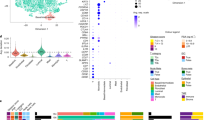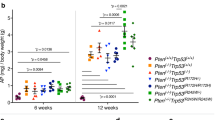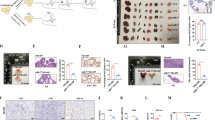Abstract
The Ron receptor tyrosine kinase (TK) is overexpressed in many cancers, including prostate cancer. To examine the significance of Ron in prostate cancer in vivo, we utilized a genetically engineered mouse model, referred to as TRAMP mice, that is predisposed to develop prostate tumors. In this model, we show that prostate tumors from 30-week-old TRAMP mice have increased Ron expression compared with age-matched wild-type prostates. Based on the upregulation of Ron in human prostate cancers and in this murine model of prostate tumorigenesis, we hypothesized that this receptor has a functional role in the development of prostate tumors. To test this hypothesis, we crossed TRAMP mice with mice that are deficient in Ron signaling (TK−/−). Interestingly, TK−/− TRAMP+ mice show a significant decrease in prostate tumor mass relative to TRAMP mice containing functional Ron. Moreover, TK−/− TRAMP+ prostate tumors exhibited decreased tumor vascularization relative to TK+/+ TRAMP+ prostate tumors, which correlated with reduced levels of the angiogenic molecules vascular endothelial growth factor and CXCL2. Although Ron loss did not alter tumor cell proliferation, a significant decrease in cell survival was observed. Similarly, murine prostate cancer cell lines containing a Ron deficiency exhibited decreased levels of active nuclear factor-κB, suggesting that Ron may be important in regulating prostate cell survival at least partly through this pathway. In total, our data show for the first time that Ron promotes prostate tumor growth, prostate tumor angiogenesis and prostate cancer cell survival in vivo.
This is a preview of subscription content, access via your institution
Access options
Subscribe to this journal
Receive 50 print issues and online access
$259.00 per year
only $5.18 per issue
Buy this article
- Purchase on SpringerLink
- Instant access to full article PDF
Prices may be subject to local taxes which are calculated during checkout





Similar content being viewed by others
References
Agus DB, Scher HI, Higgins B, Fox WD, Heller G, Fazzari M et al. (1999). Response of prostate cancer to anti-Her-2/neu antibody in androgen-dependent and -independent human xenograft models. Cancer Res 59: 4761–4764.
Becker CM, Farnebo FA, Iordanescu I, Behonick DJ, Shih MC, Dunning P et al. (2002). Gene therapy of prostate cancer with the soluble vascular endothelial growth factor receptor Flk1. Cancer Biol Ther 1: 548–553.
Chan EL, Peace BE, Collins MH, Toney-Earley K, Waltz SE . (2005). Ron tyrosine kinase receptor regulates papilloma growth and malignant conversion in a murine model of skin carcinogenesis. Oncogene 24: 479–488.
Chen YQ, Zhou YQ, Angeloni D, Kurtz AL, Qiang XZ, Wang MH . (2000). Overexpression and activation of the RON receptor tyrosine kinase in a panel of human colorectal carcinoma cell lines. Exp Cell Res 261: 229–238.
Chen YQ, Zhou YQ, Fisher JH, Wang MH . (2002). Targeted expression of the receptor tyrosine kinase RON in distal lung epithelial cells results in multiple tumor formation: oncogenic potential of RON in vivo. Oncogene 21: 6382–6386.
de Bono JS, Attard G, Adjei A, Pollak MN, Fong PC, Haluska P et al. (2007). Potential applications for circulating tumor cells expressing the insulin-like growth factor-I receptor. Clin Cancer Res 13: 3611–3616.
Dhanasekaran SM, Dash A, Yu J, Maine IP, Laxman B, Tomlins SA et al. (2005). Molecular profiling of human prostate tissues: insights into gene expression patterns of prostate development during puberty. FASEB J 19: 243–245.
Gaudino G, Follenzi A, Naldini L, Collesi C, Santoro M, Gallo KA et al. (1994). RON is a heterodimeric tyrosine kinase receptor activated by the HGF homologue MSP. EMBO J 13: 3524–3532.
Gingrich JR, Barrios RJ, Morton RA, Boyce BF, DeMayo FJ, Finegold MJ et al. (1996). Metastatic prostate cancer in a transgenic mouse. Cancer Res 56: 4096–4102.
Greenberg NM, DeMayo F, Finegold MJ, Medina D, Tilley WD, Aspinall JO et al. (1995). Prostate cancer in a transgenic mouse. Proc Natl Acad Sci USA 92: 3439–3443.
Iwama A, Yamaguchi N, Suda T . (1996). STK/RON receptor tyrosine kinase mediates both apoptotic and growth signals via the multifunctional docking site conserved among the HGF receptor family. EMBO J 15: 5866–5875.
Kassis J, Moellinger J, Lo H, Greenberg NM, Kim HG, Wells A . (1999). A role for phospholipase C-gamma-mediated signaling in tumor cell invasion. Clin Cancer Res 5: 2251–2260.
Kojima S, Inahara M, Suzuki H, Ichikawa T, Furuya Y . (2009). Implications of insulin-like growth factor-I for prostate cancer therapies. Int J Urol 16: 161–167.
Lapointe J, Li C, Giacomini CP, Salari K, Huang S, Wang P et al. (2007). Genomic profiling reveals alternative genetic pathways of prostate tumorigenesis. Cancer Res 67: 8504–8510.
Leonis MA, Toney-Earley K, Degen SJ, Waltz SE . (2002). Deletion of the Ron receptor tyrosine kinase domain in mice provides protection from endotoxin-induced acute liver failure. Hepatology 36: 1053–1060.
Logan-Collins J, Thomas RM, Yu P, Jaquish D, Mose E, French R et al. (2010). Silencing of RON receptor signaling promotes apoptosis and gemcitabine sensitivity in pancreatic cancers. Cancer Res 70: 1130–1140.
Maggiora P, Marchio S, Stella MC, Giai M, Belfiore A, De Bortoli M et al. (1998). Overexpression of the RON gene in human breast carcinoma. Oncogene 16: 2927–2933.
Mallakin A, Kutcher LW, McDowell SA, Kong S, Schuster R, Lentsch AB et al. (2006). Gene expression profiles of Mst1r-deficient mice during nickel-induced acute lung injury. Am J Respir Cell Mol Biol 34: 15–27.
Meyer SE, Waltz SE, Goss KH . (2009a). The Ron receptor tyrosine kinase is not required for adenoma formation in Apc(Min/+) mice. Mol Carcinogen 48: 995–1004.
Meyer SE, Zinser GM, Stuart WD, Pathrose P, Waltz SE . (2009b). The Ron receptor tyrosine kinase negatively regulates mammary gland branching morphogenesis. Dev Biol 333: 173–185.
O'Toole JM, Rabenau KE, Burns K, Lu D, Mangalampalli V, Balderes P et al. (2006). Therapeutic implications of a human neutralizing antibody to the macrophage-stimulating protein receptor tyrosine kinase (RON), a c-MET family member. Cancer Res 66: 9162–9170.
Peace BE, Toney-Earley K, Collins MH, Waltz SE . (2005). Ron receptor signaling augments mammary tumor formation and metastasis in a murine model of breast cancer. Cancer Res 65: 1285–1293.
Ronsin C, Muscatelli F, Mattei MG, Breathnach R . (1993). A novel putative receptor protein tyrosine kinase of the met family. Oncogene 8: 1195–1202.
Shen H, Lentsch AB . (2004). Progressive dysregulation of transcription factors NF-kappa B and STAT1 in prostate cancer cells causes proangiogenic production of CXC chemokines. Am J Physiol Cell Physiol 286: C840–C847.
Shen H, Schuster R, Lu B, Waltz SE, Lentsch AB . (2006). Critical and opposing roles of the chemokine receptors CXCR2 and CXCR3 in prostate tumor growth. Prostate 66: 1721–1728.
Shukla S, Maclennan GT, Marengo SR, Resnick MI, Gupta S . (2005). Constitutive activation of P I3 K-Akt and NF-kappaB during prostate cancer progression in autochthonous transgenic mouse model. Prostate 64: 224–239.
Thobe MN, Gurusamy D, Pathrose P, Waltz SE . (2010). The Ron receptor tyrosine kinase positively regulates angiogenic chemokine production in prostate cancer cells. Oncogene 29: 214–226.
Thomas RM, Toney K, Fenoglio-Preiser C, Revelo-Penafiel MP, Hingorani SR, Tuveson DA et al. (2007). The RON receptor tyrosine kinase mediates oncogenic phenotypes in pancreatic cancer cells and is increasingly expressed during pancreatic cancer progression. Cancer Res 67: 6075–6082.
Vicentini C, Festuccia C, Gravina GL, Angelucci A, Marronaro A, Bologna M . (2003). Prostate cancer cell proliferation is strongly reduced by the epidermal growth factor receptor tyrosine kinase inhibitor ZD1839 in vitro on human cell lines and primary cultures. J Cancer Res Clin Oncol 129: 165–174.
Wagh PK, Gray JK, Zinser GM, Vasiliauskas J, James L, Monga SP et al. (2011). beta-Catenin is required for Ron receptor-induced mammary tumorigenesis. Oncogene 30: 3694–3704.
Wagh PK, Peace BE, Waltz SE . (2008). Met-related receptor tyrosine kinase Ron in tumor growth and metastasis. Adv Cancer Res 100: 1–33.
Waltz SE, Eaton L, Toney-Earley K, Hess KA, Peace BE, Ihlendorf JR et al. (2001). Ron-mediated cytoplasmic signaling is dispensable for viability but is required to limit inflammatory responses. J Clin Invest 108: 567–576.
Wang J, Eltoum IE, Lamartiniere CA . (2007). Genistein chemoprevention of prostate cancer in TRAMP mice. J Carcinogen 6: 3.
Wilson CB, Ray M, Lutz M, Sharda D, Xu J, Hankey PA . (2008). The RON receptor tyrosine kinase regulates IFN-gamma production and responses in innate immunity. J Immunol 181: 2303–2310.
Zinser GM, Leonis MA, Toney K, Pathrose P, Thobe M, Kader SA et al. (2006). Mammary-specific Ron receptor overexpression induces highly metastatic mammary tumors associated with beta-catenin activation. Cancer Res 66: 11967–11974.
Acknowledgements
We thank Sandy Schwemberger for her assistance with the flow cytometry experiments as well as Gina Ciovacco for her technical contributions. This work was supported by Public Health Services Grant CA-125379 (SEW) from the National Institutes of Health, and by Grant Project No. PC060821 (MNT) from the Department of Defense Congressionally Directed Medical Research Program.
Author information
Authors and Affiliations
Corresponding author
Ethics declarations
Competing interests
The authors declare no conflict of interest.
Additional information
Supplementary Information accompanies the paper on the Oncogene website
Supplementary information
Rights and permissions
About this article
Cite this article
Thobe, M., Gray, J., Gurusamy, D. et al. The Ron receptor promotes prostate tumor growth in the TRAMP mouse model. Oncogene 30, 4990–4998 (2011). https://doi.org/10.1038/onc.2011.205
Received:
Revised:
Accepted:
Published:
Issue date:
DOI: https://doi.org/10.1038/onc.2011.205
Keywords
This article is cited by
-
An exome-wide rare variant analysis of Korean men identifies three novel genes predisposing to prostate cancer
Scientific Reports (2019)
-
MSP–RON signalling in cancer: pathogenesis and therapeutic potential
Nature Reviews Cancer (2013)
-
Host genetic background impacts modulation of the TLR4 pathway by RON in tissue‐associated macrophages
Immunology & Cell Biology (2013)



